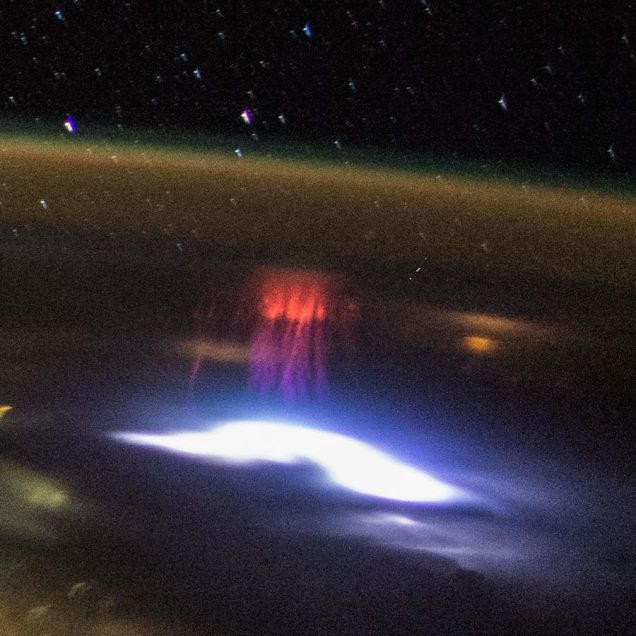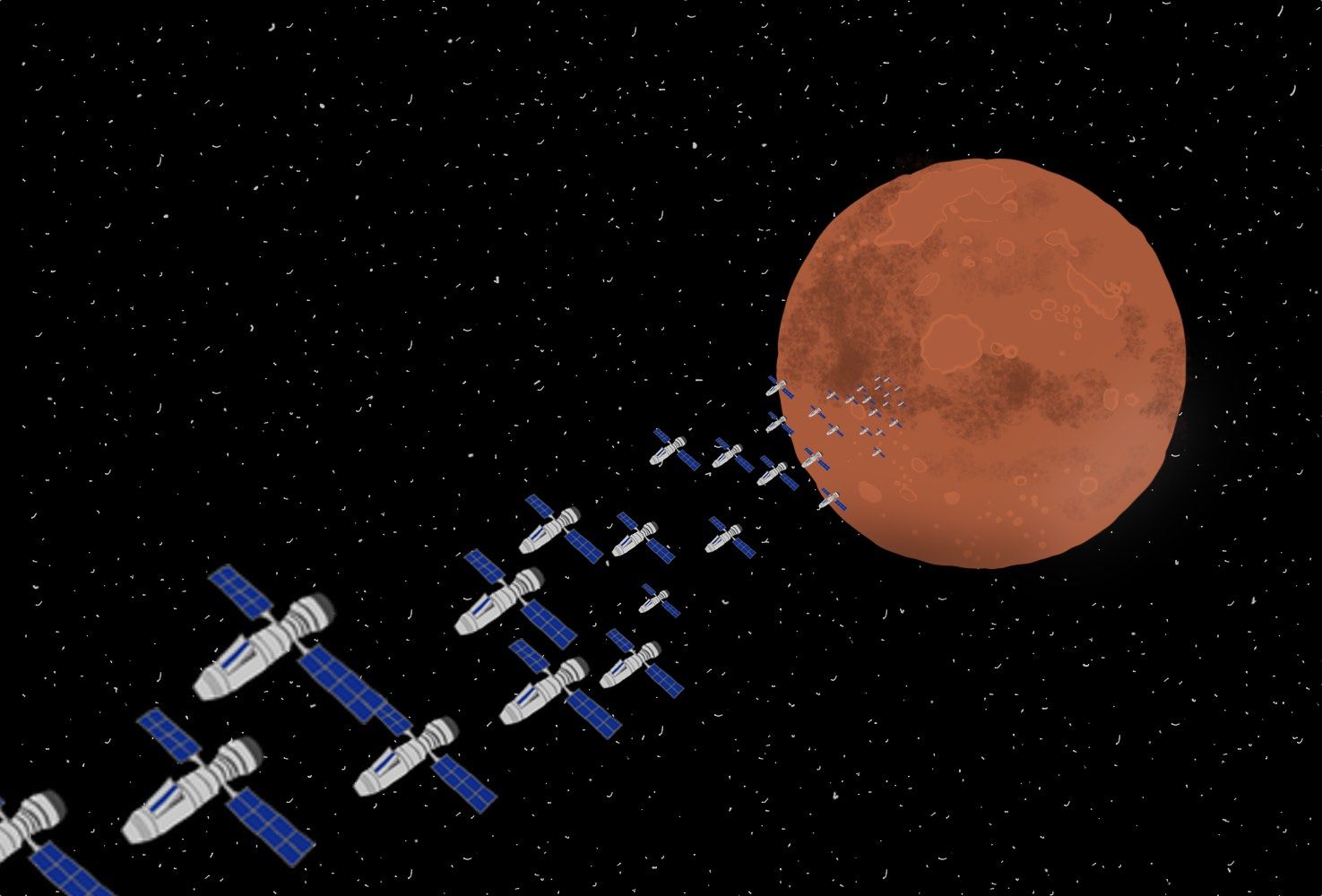Study of census results in England and Wales since 1871 finds rise of machines has been a job creator rather than making working humans obsolete.


Study of census results in England and Wales since 1871 finds rise of machines has been a job creator rather than making working humans obsolete.

Astronauts captured a red sprite from their vantage point on the International Space Station. The vibrant jellyfish is part of a thunderstorm that raged over Mexico in early August.
Red sprites are bright flashes that happen directly above thunderstorms with more mundane cloud-to-ground or intracloud lightning strikes. The sprites are brightest at an altitude of 65 to 75 kilometers (40 to 46 miles), but can extend as faint wisps as low as 30 kilometers and as high as 95 kilometers (18 to 59 miles). The sprites are red at the highest altitude, fading to blue at lower altitudes. The largest sprites cluster together in a clump of tendrils up to 50 kilometers (31 miles) across, looking vaguely like red glowing jellyfish.
.
Long time ago I was wondering why not to use drones (*) (named for that concrete application Extreme Access Flyers) to explore the space, to reach new planets, asteroids … it would be exciting … rovers are limited in action, so what if we make it airborne? Once in space, why not to send a drone or a swarm of them from the main spaceship to explore a new planet? They could interact, share capabilities, morph, etc.
While the economy looks more or less promising for civil and military, there is still a long path to walk …
“Teal Group’s 2015 market study estimates that UAV production will soar from current worldwide UAV production of $4 billion annually to $14 billion, totaling $93 billion in the next ten years. Military UAV research spending would add another $30 billion over the decade.”
Read more at http://www.suasnews.com/2015/08/37903/teal-group-predicts-worldwide-uav-production-will-total-93-billion-in-its-2015-uav-market-profile-and-forecast/
Now NASA pursues the aim of using drones to overcome the problems of rovers …
Read more at http://www.engadget.com/2015/07/31/space-drones-mars-moon-asteroid/
http://www.nasa.gov/feature/extreme-access-flyer-to-take-planetary-exploration-airborne/
(*) Using the word drone as it is more commonly used in society.
Ad Astra!
How 3D printing is changing the way we manufacture and produce is already a fact, step by step, in different areas, from aerospace to the medical areas.
How will this impact the established processes, the economy, the patient …
Is this the dawn of personalized medicine? patients will be able to print their own pills at home? Will 3D printing represent an enhancement to distribution processes?
Exciting but at the same time other questions are if following a cheap driver is really safe…
“Would the FDA be able to oversee personal pill printing? Should they? If an automated pill printer goes out of whack and misprints medication, would the blame fall on the machine’s manufacturers or the operators (i.e., the patients)? What if the machines were hacked? If people can reverse engineer patented drugs through 3D printing, how can those patents be protected? Will it be a detriment to drug development?
will people be able to hijack pill printers to manufacture illicit drugs?” This is the same situation we have now with RPAS/UAS (Remote Piloted Aircrafts/Unmanned Aircraft Systems) and cyberthreats ..
Read more at http://singularityhub.com/2015/08/14/first-3d-printed-drug-ushers-in-era-of-downloadable-medicine/
Project Sunroof maps out how much sun and shade hit homes on any given day. Head here to See how much shine your home gets and if solar power is good for you.
Videos of creepy robots trying their best to walk like humans (with absolutely no help from their abusive owners) are nothing new, but this new footage of the Atlas humanoid walking robot, developed by Google-owned company Boston Dynamics, is a game changer.
Usually these videos are shot in a lab, or on a treadmill — an artificial environment where the terrain that the robot is walking on can be controlled and maintained.
However, the latest video from the Boston Dynamics team, which gets funding from the US Defence budget, shows the Atlas robot running through a real forest.
Quoted: “Sometimes decentralization makes sense.
Filament is a startup that is taking two of the most overhyped ideas in the tech community—the block chain and the Internet of things—and applying them to the most boring problems the world has ever seen. Gathering data from farms, mines, oil platforms and other remote or highly secure places.
The combination could prove to be a powerful one because monitoring remote assets like oil wells or mining equipment is expensive whether you are using people driving around to manually check gear or trying to use sensitive electronic equipment and a pricey a satellite internet connection.
Instead Filament has built a rugged sensor package that it calls a Tap, and technology network that is the real secret sauce of the operation that allows its sensors to conduct business even when they aren’t actually connected to the internet. The company has attracted an array of investors who have put $5 million into the company, a graduate of the Techstars program. Bullpen Capital led the round with Verizon Ventures, Crosslink Capital, Samsung Ventures, Digital Currency Group, Haystack, Working Lab Capital, Techstars and others participating.
“This cluster of technologies is what enables the Taps to perform some pretty compelling stunts, such as send small amounts of data up to 9 miles between Taps and keep a contract inside a sensor for a year or so even if that sensor isn’t connected to the Internet. In practical terms, that might mean that the sensor in a field gathering soil data might share that data with other sensors in nearby fields belonging to other farmers based on permissions the soil sensor has to share that data. Or it could be something a bit more complicated like a robotic seed tilling machine sensing that it was low on seed and ordering up another bag from inventory based on a “contract” it has with the dispensing system inside a shed on the property.
The potential use cases are hugely varied, and the idea of using a decentralized infrastructure is fairly novel. Both IBM and Samsung have tested out using a variation of the blockchain technology for storing data in decentralized networks for connected devices. The idea is that sending all of that data to the cloud and storing it for a decade or so doesn’t always make economic sense, so why not let the transactions and accounting for them happen on the devices themselves?
That’s where the blockchain and these other protocols come in. The blockchain is a great way to store information about a transaction in a distributed manner, and because its built into the devices there’s no infrastructure to support for years on end. When combined with mesh radio technologies such as TMesh it also becomes a good way to build out a network of devices that can communicate with each other even when they don’t have connectivity.”
Read the Article, and watch the Video, here > http://fortune.com/2015/08/18/filament-blockchain-iot/

Graphene is not the only game in town.
Two new developments show that the race is on to replace silicon as the go-to semiconductor of choice with other 2D materials if not graphene.

Synthetic biology is radical and has huge potential to revolutionize multiple industries. The fact is biology has already worked out efficient ways of doing things, or has in place mechanisms we can adapt, so why reinvent anything if we can simply adapt what’s already here? Using billions of years of evolution makes logical sense, and that’s what synthetic biology builds on.
So here is a great video by Grist, explaining what synthetic biology is and what we might be able to do with it in the future.